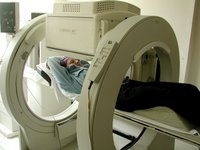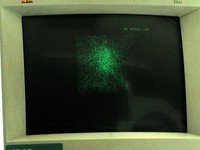MuGA? Ugh-a.
Actually, it wasn't that bad this time.
Remember way back in December, when we had to go in for a MuGA scan? We got to repeat the experience yesterday. Woo-hoo!
Backstory: For Jody's first trip around the carousel in 2001, there was a new drug called Herceptin being tested in clinical trials. It had already been shown to be effective against cancer, but there were concerns about its potential side-effects; specifically, that for patients taking Adriamycin, it could lead to congestive heart failure. At the time, these risks were of such concern that Herceptin was only indicated in women with metastatic disease.
Flash-forward five years, and much more is known about Herceptin. For one thing, it's a damned effective drug: one of the best new cancer drugs to come out in the past few years. For many patients, the risks of taking Herceptin were already outweighed by its potential benefits. But fortunately, there's now also a lot more data available on Herceptin's potential for cardiac damage; so much more is known, in fact, that the drug is now regularly prescribed for women with breast cancer. The caveat is, during the period it's being administered, the docs will monitor the patient's heart to be sure it's not being compromised.
Jody's December MuGA scan was her baseline. Yesterday was her three-month follow-up (yes, December is five months ago, but yesterday was exactly three months from when she started on the Herceptin).
The procedure was pretty much the same as last time, except it went a lot more smoothly, and there were fewer waiting-room theatrics. In a nutshell, we got to the hospital, went straight to nuclear medecine, and had the procedure explained (a formality at this point). After a brief wait, Jody had some blood drawn. We were then told to kill half an hour, which we did walking around outside and shopping a bit. When we came back, Jody's blood, now mixed with a radioactive element called Technetium, was reinjected into her bloodstream. This made the blood visible on a device known as a gamma camera (which can "see" the radiation). The GC was aimed at Jody's chest, and Presto! It captured various stages of her heart's pumping cycle. Jody had to sit absolutely still with her arms over her head during the two periods of acquisition (one of ten minutes, one of five). On the plus side, the machine she was on was far more "open" than the one used in December's test.
(For more information on a MuGA scan for you geeks out there, here's a Wiki entry.)
We don't have the results back yet, but here are some cool pictures:


Note: According to this fact sheet, ""For the technetium that is distributed to organs other than the thyroid, about 75% leaves the body with a biological half-life of 1.6 days, 20% clears with a half-life of 3.7 days, and 5% clears with a half-life of 22 days." If I read that correctly, that means my wife is still radioactive. Which might explain the odd glow coming from her side of the bed this evening. :)
Remember way back in December, when we had to go in for a MuGA scan? We got to repeat the experience yesterday. Woo-hoo!
Backstory: For Jody's first trip around the carousel in 2001, there was a new drug called Herceptin being tested in clinical trials. It had already been shown to be effective against cancer, but there were concerns about its potential side-effects; specifically, that for patients taking Adriamycin, it could lead to congestive heart failure. At the time, these risks were of such concern that Herceptin was only indicated in women with metastatic disease.
Flash-forward five years, and much more is known about Herceptin. For one thing, it's a damned effective drug: one of the best new cancer drugs to come out in the past few years. For many patients, the risks of taking Herceptin were already outweighed by its potential benefits. But fortunately, there's now also a lot more data available on Herceptin's potential for cardiac damage; so much more is known, in fact, that the drug is now regularly prescribed for women with breast cancer. The caveat is, during the period it's being administered, the docs will monitor the patient's heart to be sure it's not being compromised.
Jody's December MuGA scan was her baseline. Yesterday was her three-month follow-up (yes, December is five months ago, but yesterday was exactly three months from when she started on the Herceptin).
The procedure was pretty much the same as last time, except it went a lot more smoothly, and there were fewer waiting-room theatrics. In a nutshell, we got to the hospital, went straight to nuclear medecine, and had the procedure explained (a formality at this point). After a brief wait, Jody had some blood drawn. We were then told to kill half an hour, which we did walking around outside and shopping a bit. When we came back, Jody's blood, now mixed with a radioactive element called Technetium, was reinjected into her bloodstream. This made the blood visible on a device known as a gamma camera (which can "see" the radiation). The GC was aimed at Jody's chest, and Presto! It captured various stages of her heart's pumping cycle. Jody had to sit absolutely still with her arms over her head during the two periods of acquisition (one of ten minutes, one of five). On the plus side, the machine she was on was far more "open" than the one used in December's test.
(For more information on a MuGA scan for you geeks out there, here's a Wiki entry.)
We don't have the results back yet, but here are some cool pictures:


Note: According to this fact sheet, ""For the technetium that is distributed to organs other than the thyroid, about 75% leaves the body with a biological half-life of 1.6 days, 20% clears with a half-life of 3.7 days, and 5% clears with a half-life of 22 days." If I read that correctly, that means my wife is still radioactive. Which might explain the odd glow coming from her side of the bed this evening. :)

0 Comments:
Post a Comment
<< Home